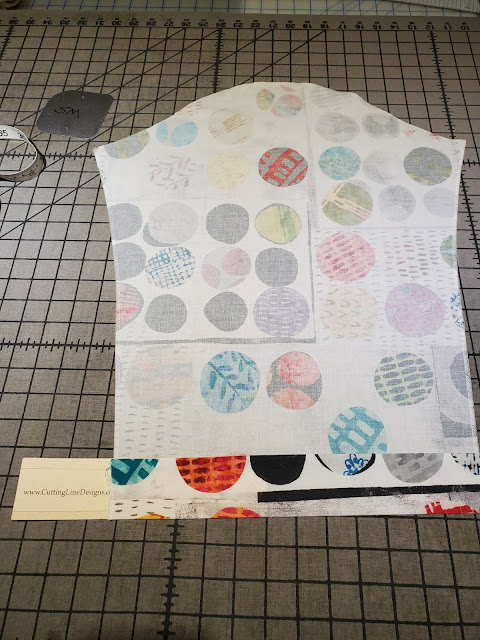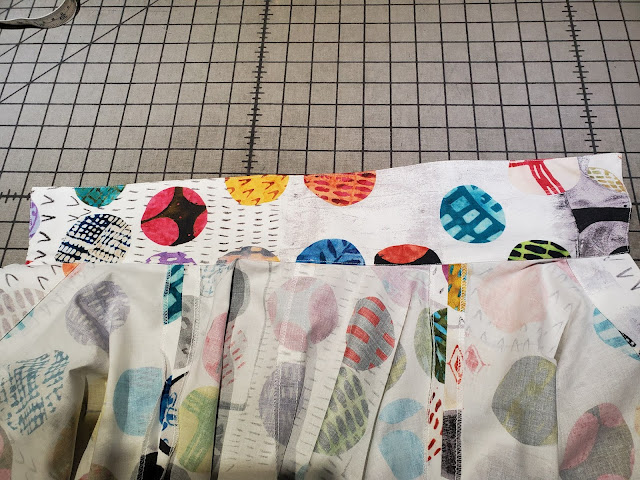Hello all you creative sewers out there,
This blog post is going to show you a fabulous project. It's one of Louise's inventions; she taught it at 2 ASG Conferences and at a retreat or two. Now we'd like to show you how it all works, so you can do it yourself at home. We've had many requests to teach this again in person, but we decided to extend the how-to's for all of you instead.
Louise based her vest on our Light and Shadow pattern. She used the usual pattern pieces to create her vest. The special part of this is the applique and the faux sashiko stitching she designed with. In this post, I'll show you step by step photos of how she created the unique look. Please read through the entire blog so you'll understand the process before you start.
She cut out the vest pieces from linen. Then she chose a print (use linen or cotton) to cut up for her applique pieces. This one had so many colors in the print that she only needed one fabric for all the appliques.
Let's see the vest, so you can see how fabulous this project can look. Here's the finished vest back:
And the finished front: right front over left front. You can see how the cowl drapes in this photo.
You can also see that she didn't fussy cut individual shapes from the print. Instead, she cut circles and blocks in interesting shapes, even cutting through some individual motifs in the fabric. Take a close look to see what I mean. Also note that some small appliques slide just a bit under the edges of larger appliques. Here's the back laid flat on the table to give you a clearer view:
I'll point out a few details, then explain how the process works. Note the little tabs tucked under the circle at the upper right. Below that is a long strip with a short strip tucked under it near the top, and on its left a triangular shape with one edge tucked under. Three blocks on the left overlap each other slightly, with 2 small shapes added. On the left side seam edge is a strip folded double, with its folded edge extending onto the back piece. When the side seam is sewn, the raw edges will be caught in the seam, while the folded edge will extend from the seam. (I'll address the faux sashiko stitching later.)Let's talk about how this works. Cut out your vest pieces and set then aside for a few minutes. Lay out your applique fabric(s) and just look them over. Begin cutting out shapes: squares, rectangles, strips of varying lengths and widths, circles, half circles, etc. It's more effective to keep the designs abstract, focused on the colors, than to fussy-cut flowers, leaves, or other motifs. Once you have lots of shapes, begin laying some of them on a vest piece, moving them around until you like the overall look. Here's Louise's preliminary layout on the back. You can see the raw edges of her applique pieces.
Another view of the back. Note that the small pieces that will eventually tuck under the larger pieces are on top at this stage.
This photo shows that folded piece at the side seam. She eventually shortened this to keep it out of the miter.
Once you've finished your applique layout on a vest piece, take a photo to help you remember your design. Also, put pins around each shape so you'll put it back in the same place as before. Like this: Above is a photo of the cowl with pins marking the location of each applique. Keep all your applique pieces near center front of the cowl. (At the sides and back, you'll want to allow the cowl to fold down on itself; appliques would make it too stiff there.) Once you've marked placements with pins, remove the pieces. You'll have this:NOTE: Place your Right Front vest piece on top of the Left Front vest piece. Use chalk to mark the edge of the Right Front on the Left Front. You won't need any applique on the Left Front where it lies under the Right Front. Here are Louise's right and left fronts with their preliminary placements.The next step is to deal with the edges of the appliques. First, let's talk about the circles. Make 2 templates from file folders or similar materials. One will be the size of a circle you want to cut. Make the second template 1/4" smaller all the way around; you'll use it to press the raw edges under. Staystitch, using a regular stitch length, all the way around each fabric circle, 1/4" from the raw edge. Lay the fabric circle wrong side up on the ironing board with the smaller circle template centered on it. Carefully press a 1/4" hem over the small template to give the fabric circle a finished edge.
Also staystitch 1/4" from the raw edges of all the other shapes. Use a Pressing Template to press a 1/4" hem on all edges of each shape, except where an edge of a small piece will extend under a larger piece.
Once all your raw edges are pressed under, place strips of Steam-a-Seam on the 1/4" hems, sticky side down (pieces are wrong side up on the ironing board). Press lightly, then remove the paper backing.
Using the pins for reference, begin placing the appliques right side up in the placements marked by the pins. Of course, each piece is slightly smaller now because of the hems, but your placement will be just about the same. Also refer to the photos you took as you did the preliminary outline on each vest piece.
Once you're satisfied with your placements, press each applique piece to keep it in place.
Using a 2.5 or 2.0 stitch length and matching thread, edgestitch each applique shape. I find a blind hem foot, adjustable blind hem foot, or edge joining foot works well, along with moving the needle.
At this point, your applique design is finished. In the next blog post, I'll address the faux sashiko stitching.


























































